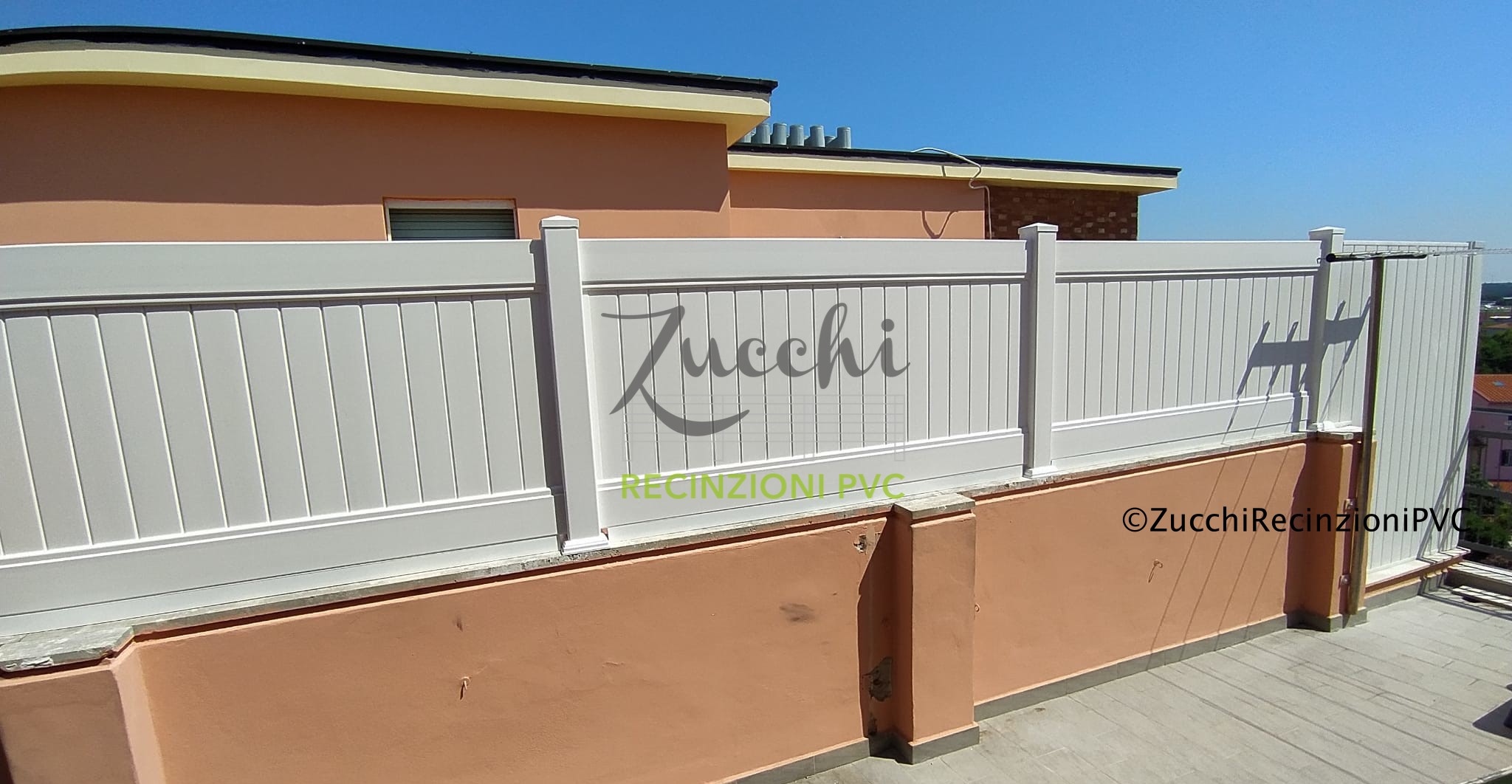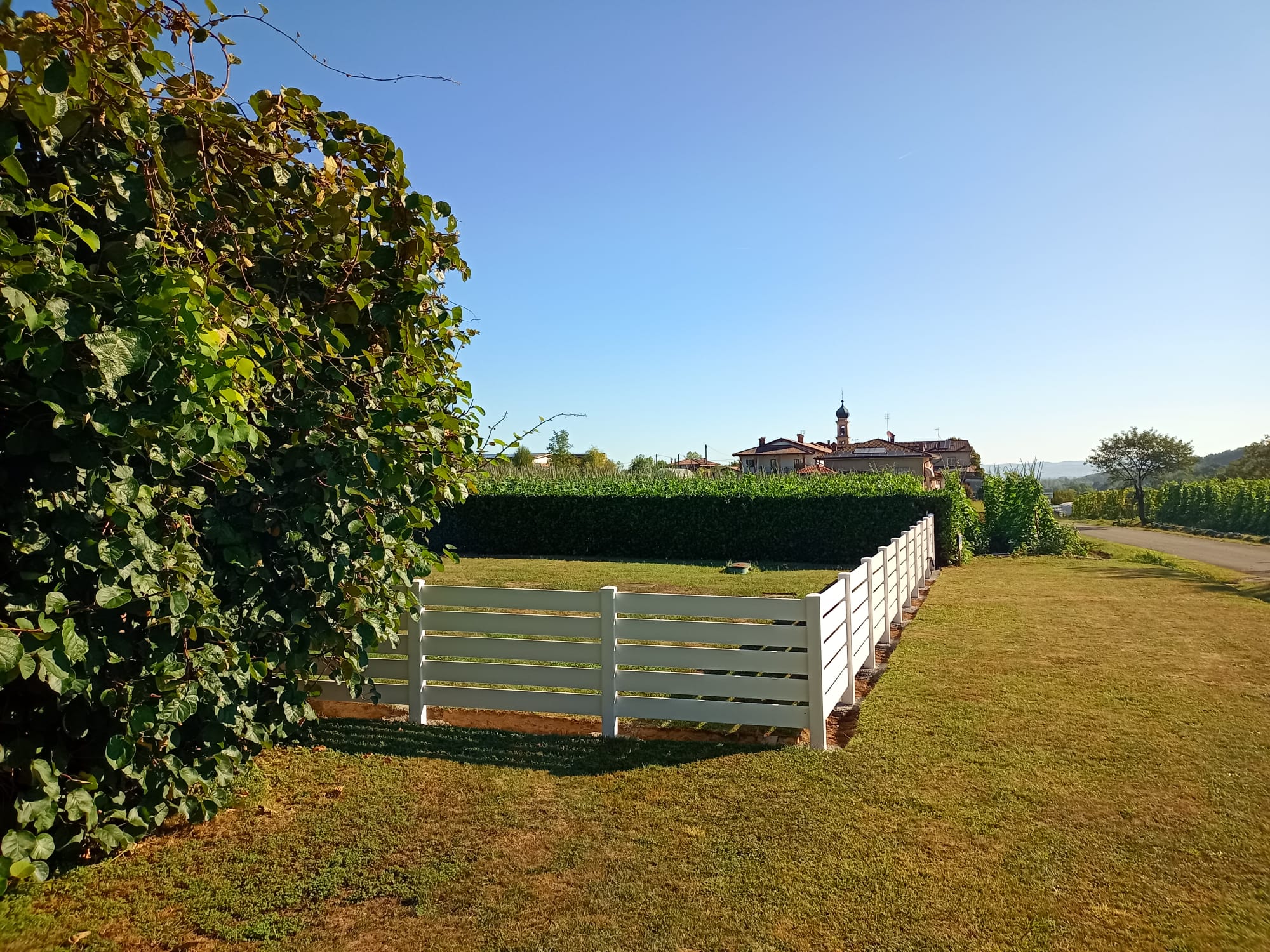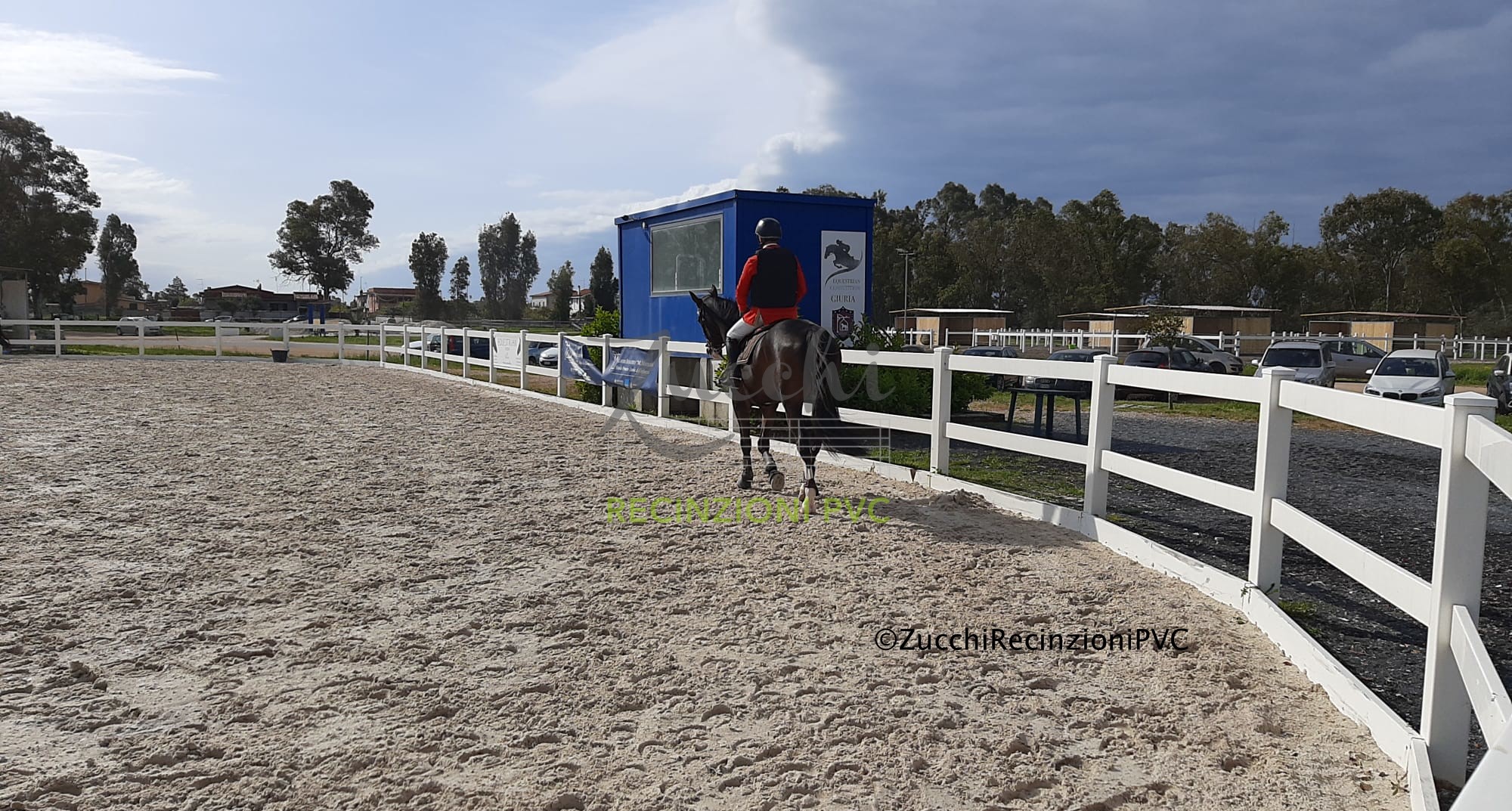Modern choices for those who love simplicity.
When you think of a garden fence, you probably imagine something rustic, made of wood, perhaps with peeling paint. But if you love clean lines, smooth surfaces, and an aesthetic that complements modern outdoor spaces, then PVC panels are exactly what you’ve been looking for. In recent years, PVC has evolved tremendously. Gone are the days of shiny, toy-like plastic. Today, you can find elegant, matte panels in neutral colors such as ice white, anthracite gray, or taupe, perfect for outdoor spaces with a minimalistic taste. Among the most popular options are vertical slats and solid panels, each with its own character and advantages. Not sure where to start? I’ll explain it to you in a simple way.Vertical slats: airy, light, and decidedly modern.
Vertical slats are the perfect choice if you want a “palisade” effect, but much more refined and contemporary. Imagine a series of thin, straight slats with regular spaces between them. The result is a fence that protects you without making you feel trapped. This style pairs perfectly with modern homes, especially those with geometric façades, floor-to-ceiling windows, and minimalist garden designs. The visual rhythm created by the vertical slats is light and dynamic: it allows air and light to pass through while still providing a reasonable level of privacy, especially if you choose narrow, closely spaced slats. Want a tip? If you love the minimal effect, go for slats without frames or decorations. The simpler, the better. Installation is also quite quick, and some panels come pre-assembled, so you just need to fix them to the ground or a base structure. Perfect if you don’t want to spend days with drills and levels. Additionally, if you have ornamental plants or low hedges, vertical slats allow the vegetation to play with shadows, creating spectacular visual effects. In the evening, with the right lighting, it can almost look like a design hotel set.Solid panels: total privacy and bold style.
If your goal, instead, is to create a private oasis, shielded from prying eyes or overly nosy neighbors, then solid panels are the right choice for you. Imagine a smooth, continuous wall in a uniform color, surrounding your outdoor space with elegance and character. Unlike vertical slats, these panels leave no gaps, providing a complete visual barrier. But that doesn’t mean they are heavy or unattractive—quite the opposite! Modern PVC solid panels are minimal, geometric, and feature finishes that resemble stone or brushed metal. Plus, they’re very easy to clean: a simple wipe with soap and water brings them back to like-new condition. Another advantage? Silence. Solid panels slightly absorb noise, which can be very useful if you live near a busy street or a noisy playground. They give you a sense of visual and acoustic tranquility, as if you’ve brought a little spa corner into your garden. Aesthetically, they pair well with modern homes in neutral tones, but also with concrete surfaces, resin flooring, or outdoor spaces furnished with metal and teak furniture. And if you want to create an interesting contrast, you can alternate sections of solid panels with open modules: the effect is magazine-cover worthy.Which one to choose? It depends on you (and your style).
Now that you know the main differences between vertical slats and solid panels, you’re probably wondering: which one is right for me? And the answer is: it depends on what you want your outdoor space to convey. If you’re someone who loves open air, light contrasts, dynamic design, and transparent architecture, vertical slats are the way to go. If, instead, you want to create a private refuge that is visually clean, protected, and intimate, solid panels will make you feel in a safe and stylish space. And nothing stops you from combining both! Many architects play with alternating modules to define different areas of the garden: a more open relaxation zone, a more protected dining area, or a technical space hidden from view. PVC gives you the freedom to customize without hassle, as it is lightweight, versatile, and available in a wide variety of options.Lets the air through, not the eyes: plays with space.
When you think of your ideal fence, you probably want it to be beautiful, functional, and… a bit strategic, right? You want to enjoy the summer breeze without every passerby peeking into your garden while you sip your coffee in pajamas. This is where PVC panels with spatial designs come into play: solutions that let you breathe while protecting you from prying eyes. If you don’t want to give up either privacy or an airy, contemporary aesthetic, you’re in the right place. I’ll show you how to use solid and open sections to create a fence that is beautiful, smart, and perfectly in line with your style.Space between slats: the secret of the “see-but-not-see” effect.
You know those fences that seem as light as air, yet actually hide much more than they reveal? These are panels with spaced slats, usually vertical or horizontal, with gaps calculated down to the millimeter to ensure both privacy and airflow. They are perfect if you love a minimal design but don’t want to be enclosed behind a solid, stifling wall. These spatial designs allow light to enter, wind to circulate, and unwanted eyes to… stay out. The secret lies entirely in the proportion between void and solid: slats that are too far apart create transparency, while those too close together feel heavy. With modern PVC panels, you can find the perfect balance, choosing the style that best suits your home. Many models, for example, feature 10 cm slats with 2–3 cm gaps: enough to let the garden breathe, but not so much that it turns into a reality show for the neighbors.Strategic orientation: vertical, horizontal, or diagonal?
The orientation of the slats can completely change the visual impact of your fence. Vertical slats elongate, add an elegant touch, and are perfect for urban settings or modern villas with clean lines. Horizontal slats, on the other hand, create a sense of continuity, ideal for wide gardens and spaces with low vegetation. And then there are diagonal or alternating variants, perfect if you want a slightly more creative touch while keeping it minimal. The goal remains the same: block the view, not the airflow. With the right slats, you can protect your privacy without creating a heavy visual barrier. Another trick? If you position the slats slightly staggered, like a louvered effect, you let even more air in without creating “gaps” in your privacy. It’s like having a window that’s always open… but without letting anyone see inside!Playing with shadows: the design changes with the light.
One of the most underestimated aspects of fences with spatial designs is the light and shadow effect they create throughout the day. As the sun moves, the slats cast geometric, dynamic shadows that transform the fence into a living element. If you choose a neutral color like anthracite or pearl gray, the visual effect will be even more sophisticated and modern. Morning light? Thin, delicate shadows. Sunset? Sharp, dramatic contrasts, perfect for a dinner under the stars. And you get all this without changing a thing: just thanks to the smart structure of your fence. This theatrical play also has a secondary effect: it distracts the eye. Anyone looking from outside doesn’t focus on what’s inside, but is captivated by the patterns of light moving across the surfaces. A solution that is as aesthetic as it is functional.Combining fences with privacy screens or minimal plants.
A fence alone doesn’t always manage to do it all: protect, decorate, let the space breathe, and maintain a coherent style. If you’ve chosen a modern, minimalist design, you probably want a fence that is elegant but not too intrusive, able to harmonize with the garden. And this is exactly where privacy screens and minimal plants come into play, two perfect allies to complete the wow effect. Combining PVC panels with natural or architectural elements allows you to create an aesthetic that is lighter, coherent, and functional. Let’s see how to do it without complicating things, while keeping the clean style you love.The modern privacy screen: geometric, slim, and clever.
You know those old woven wooden or bamboo windbreaks that used to be common? Forget them. Today, the privacy screen is a true design element, capable of adding character without weighing down the space. You can pair it with your PVC fence by choosing lightweight materials, perhaps with matte or perforated textures, ideal for screening without closing off the space. The most modern privacy screens are made of painted aluminum, corten steel, or the same PVC as the fence, maintaining perfect visual continuity. Want a touch of style? Choose a laser-cut geometric panel to place alongside the fence. You can use it as a divider between two areas—like a dining area and a relaxation zone—or to “hide” a technical part, such as an air conditioner or compost bin. The great thing is that these elements are easy to install, durable, and require no maintenance. And the best part? They give you a sense of intimacy without feeling like a wall.Minimal plants: green, light, and low-maintenance.
If you love nature but don’t want a garden that looks like a tropical forest, know that minimal plants are your salvation. Choosing a few well-kept varieties with clean lines helps highlight the fence and create depth in the space. Among the most popular choices is dwarf bamboo, perfect for accompanying a tall or modular fence. It grows quickly, has a vertical posture, and instantly adds a zen touch, especially when paired with a white or gray fence. Another timeless classic? Ornamental grasses, which sway elegantly in the wind and create movement without visual clutter. If you want a more graphic effect, opt for concrete or metal pots, placed along the fence. Fill them with plants like bonsai olive trees, Ficus retusa, or lavender pruned into spheres. The contrast between artificial geometries and natural forms creates a space that is orderly yet welcoming. And don’t forget a key detail: plants also help filter noise, provide shade, and improve the microclimate. So, besides the design, you’re also enhancing the livability of your garden.Perfect mix: when PVC, plants, and privacy screens go hand in hand.
The real trick for a successful modern garden lies in balance: no element should dominate the others, but everything should harmonize. A PVC fence with clean lines can become the perfect backdrop to highlight a vertical green wall or a row of plants. Similarly, a geometric privacy screen can serve as a frame for a relaxation corner with two chaise lounges and a minimalist table. An idea that always works? Use the fence as a solid base, add a privacy screen only at a strategic point, and complete the setup with two or three carefully chosen plants. The result will be balanced, harmonious, and truly modern—just like the covers of interior design magazines. Remember: height matters too. If your fence is low, you can use plants to gain privacy. If it’s tall and solid, add vertical elements to visually lighten the space and create movement. And the best part? You can customize everything without having to redo the entire structure. Simply change the pots, add a vertical green wall, or swap a decorative panel to give your garden a fresh new look.DIY project or architect? What’s really worth it?
You’ve decided to install a PVC fence in your garden, perhaps with a modern and minimal design, and you’re wondering: should I do it all myself or call an architect? The truth is that both options have advantages, but it all depends on how much time, energy, and precision you want to put into the project. Spoiler: there isn’t one right answer for everyone, but there is definitely the right choice for you. Let’s find out together how to figure it out.The charm (and challenges) of smart DIY
If you love tinkering, spending weekends in the garden, and like the idea of seeing a job done with your own hands, DIY can be very rewarding, as well as a great way to save some money on the final cost. PVC panels, especially modular ones, are designed precisely for those who want to give it a try. They often come with clear instructions, screws included, pre-drilled brackets, and maybe even video tutorials to follow step by step. You don’t need to be an expert builder or an engineer—just a good amount of attention and a bit of patience. Of course, you’ll also need a few tools at home — like a drill, a laser level, and maybe a willing helper. But the real challenge of DIY is planning: knowing where to place the posts, how much space to leave, and how to avoid measurement errors. Here’s a golden tip: never start blindly. Make a sketch on paper, take accurate measurements, check slopes and obstacles. Half a day of planning can save you an entire weekend of frustration and misplaced screws.The architect’s help: less stress, more precision
If your goal is to have a garden that looks like it came out of a magazine, and you don’t have the time or desire to work on it yourself, asking for the help of an architect or landscape designer can be the smartest choice you can make. A professional helps you make harmonious choices, taking into account the house’s aesthetics, sun orientation, desired privacy, and even local regulations (which can sometimes be more complicated than expected). Additionally, they can advise you on materials, colors, and finishes that align with the architectural language of your home. We’re not just talking technical drawings: many architects show realistic renders, inspiration moodboards, and help you visualize the final result. This way, you can make choices without surprises, knowing exactly what the outcome will be. Of course, there’s an extra cost, but it’s often offset by efficiency and beauty. And if your garden is large, complex, or has constraints (like boundary walls, slopes, or hidden access points), the help of an expert can really make the difference between “okay” and “wow.”The middle path: you design, they refine
What if I told you that you can have the best of both worlds? More and more people today choose a “hybrid” solution, where you handle the idea, the style, and maybe even the installation, but leave some key parts to a professional. For example: you could choose the PVC fence model yourself, study the style, decide where you want the openings, but then have the project checked by an architect to avoid technical errors or aesthetic “blunders.” Or you could install everything yourself, but get a brief initial consultation to clarify ideas on materials, colors, and measurements. It’s like having a personal trainer for your home: they don’t do everything for you, but they put you on the right track. Many architects offer light packages, perfect for small projects: a remote chat, a basic drawing, or a 3D simulation. With little expense, you save yourself a lot of second-guessing. And if you later realize you don’t have the time or desire? You already have a professional ready to step in without having to start all over again.Conclusion: choose based on yourself, not just your budget
At the end of the day, it’s not just about saving or spending: it’s about understanding how you want to experience your project. If you love getting hands-on, experimenting, and have free time, DIY can be rewarding and even fun. If, on the other hand, you want zero stress, a guaranteed result, and the expert eye of someone who does this professionally, hiring an architect is a smart choice. And in between, there’s a middle ground perfect for those who want to manage but not make mistakes.. A PVC fence can be much more than just a barrier: it’s part of your outdoor space, your style, and your daily life. So make the choice that makes you feel good, brings a smile to your face, and makes you say, once the project is finished: “Yes, this is exactly what I wanted.”







Leave A Comment